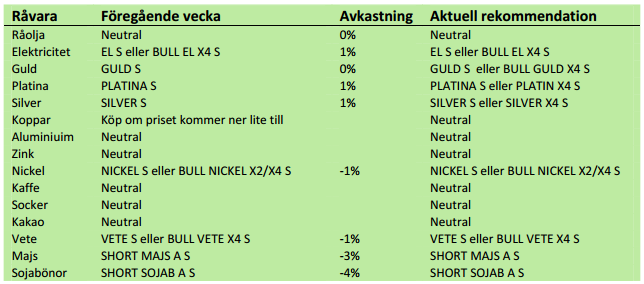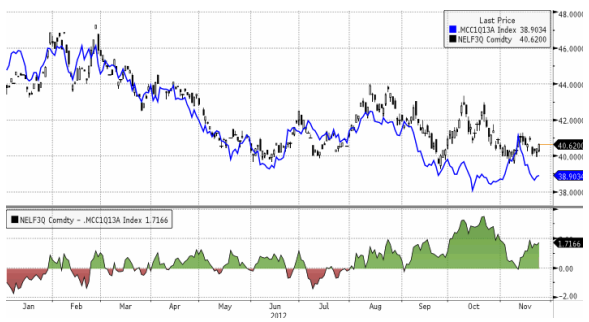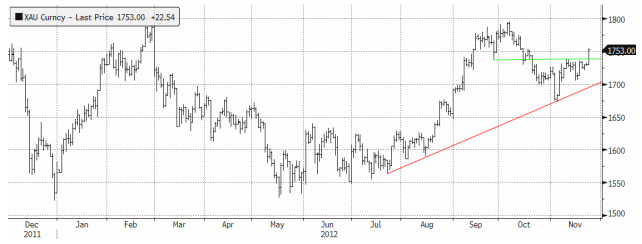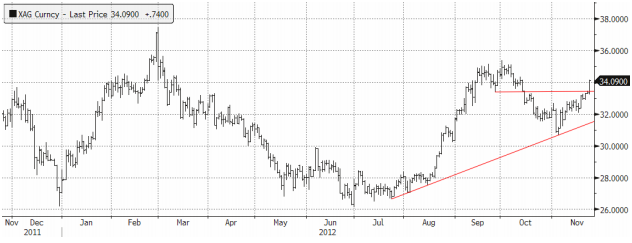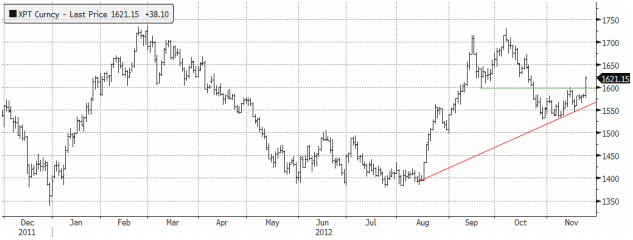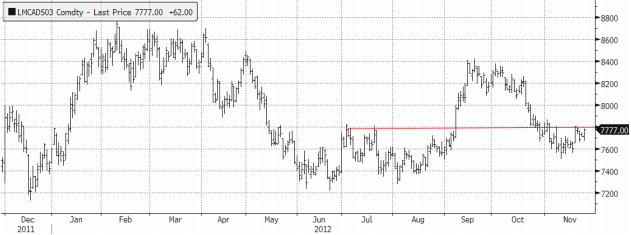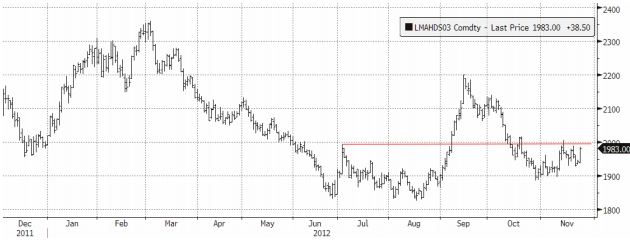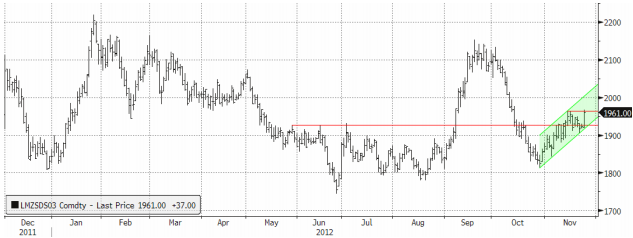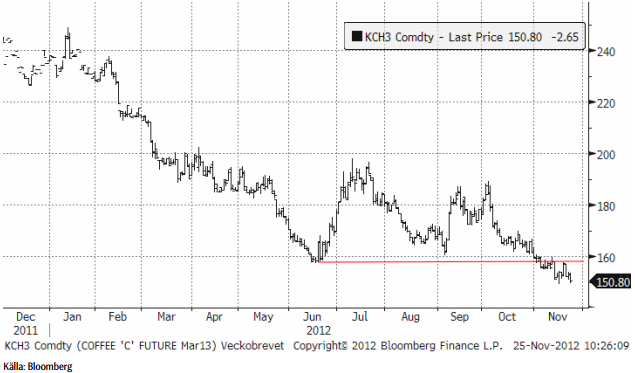Analys
SEB – Råvarukommentarer, 26 november 2012
Rekommendationer
Vi plockar upp rekommendationen på el. Väderskiftet ger en stark öppning idag på morgonen.
Prisuppgången för nickel under veckan har motverkats av den lägre dollarkursen. Majs och sojabönor rekylerade upp i veckan som gick, vilket fick våra positioner i SHORT-certifikat att slå tillbaka. Vi ligger kvar med den korta rekommendationen. Guld,silver och platina stärktes och får kortsiktigt nya köpsignaler. Bullkontrakten kan övervägas kortsiktigt för den som vill ta mer risk. Vi är fortsatt neutrala till oljan.
Råolja – Brent
Situationen i Mellanöstern, speciellt konflikten mellan Hamas och Israel i och kring Gazaremsan, har präglat veckan som varit. Ett vapenstillestånd har slutligen kommit på plats men konflikten väntar på en permanent lösning. Syrien och embargot mot Iran, utgör ytterligare hot. Marknaden har samtidigt prisat in en bättre balans mellan utbud och efterfrågan efter de senaste nedjusteringarna av efterfrågan samt starka produktionssiffror från länder som Irak och Libyen. Ny data indikerar att oljemarknaden var välbalanserad under årets tredje kvartal. Efterfrågan för både 2012 och 2013 har också nyligen justerats ned av ”de 3 stora”, se tabell.
Veckans DOE rapport visade att de amerikanska råoljelagren minskade med 1,5 mfat. Distillates föll med 2,7 mfat och bensinlagren minskade med 1.5 mfat.
I Europa är det fortsatt fokus på den ansträngda lagersituationen för mellandestillat. För diesel är det lite mindre ansträngt än tidigare, efter att många raffinaderier nu producerar för fullt igen efter säsongsmässiga underhållsarbeten. Dessutom har man i möjligaste mån lagt om produktionen mot maximal andel diesel men sammantaget är situationen mycket ansträngd, se grafer nedan. Mellandestillaten utgör en stödjande faktor för Brent, som lämpar sig väl för produktion av mellandestillat.
I veckan har Brentkontraktet stigit med ca 2 usd till 111 usd. Vår tolkning är att den geopolitiska osäkerheten, i nuläget, är den starkare kraften kontra bättre utbuds-/efterfrågebalans. Kring nuvarande nivå håller vi en neutral vy men vi håller fast vid att 105-106 nivån, är köpvärd, då;
- Vi det bedömer det som osannolikt att priset på råolja, varaktigt, kommer att falla under 105-nivån, såvida inte tillväxtprognoserna skrivs ned väsentligt. Den senaste statistiken från både Kina och USA indikerar att det värsta kanske ligger bakom oss. Samtidigt är situationen i Europa fortfarande illavarslande.
- Oljepriset kommer att fortsätta vara väl understött av stora geopolitiska risker. Ökad spänning i veckan som varit, har redan lyft priset.
- Det krävs ett högt oljepris för att stimulera tillräckliga investeringar i ny kapacitet.
- Många producentländer behöver ett högt pris för att balansera budgeten.
- Brent lämpar sig väl för produktion av mellandestillat som bensin och diesel. Lagren av mellandestillat är historiskt låga och den kommande vintern riskerar att urholka lagren ytterligare.
- Produktionen i Nordsjön har, under hösten, varit kraftigt begränsad. Problemen skulle nu ha varit lösta men ytterligare störningar och förseningar har meddelats.
Elektricitet
Vädret under hösten har varit milt och nederbördsrikt och den hydrologiska balansen är stark, ca +12 TWh jämfört med normalt. 2011 och 2012 går till historien som ”våtår” med mycket god vattentillgång. Spotpriset på Nord Pool har därför varit pressat med rekordlåga nivåer i somras. Sedan dess har priset stigit, it takt med att efterfrågan säsongsmässigt ökat. Många befarade att en mild höst med mycket regn skulle leda till ytterligare priskollaps under hösten. Dessa farhågor har inte infriats, producenterna har visserligen varit hårt pressade och tvingats köra vattenkraften för fullt men man har ändå parerat situationen väl, trots att kärnkraften nu producerar ca 95% av fullt.
I veckan som varit har terminerna handlats sidledes. Vi håller fast vid vår long position trots att differensen mellan kostnaden att producera el i kolkraftverk vilket oftast är marginalprissättande och elterminerna, nu ökat en del, se graf.
I grafen är marginalkostnaden för kolkraft, blå linje, justerad. Verklig marginalkostnad är lägre.
Den utlösande faktorn för högre elpriser kommer sannolikt vara ett väderskifte. Sommaren och hösten har varit nederbördsrik. Blötvädret har varit inprisat, varför ett skifte till kallare och torrare väder bäddar för snabb uppgång. De båda uppgångar som skedde i oktober följde båda på moderata väderleksskiften, vilket visar på potentialen. Vår rekommendation har varit och är att ligga steget före, alltså att köpa innan ett eventuellt väderskifte, då det med stor sannolik kommer vara försent att agera när skiftet väl bekräftas.
I skrivande stund, söndag den 25 november, har faktiskt väderprognoserna skiftat till både kallt och torrt. Skiftet skedde efter fredagens stängning. Ser vi samma typ av prognos måndag morgon, så får vi ett ypperligt tillfälle att testa potentialen i vår long position. Men såvida inte ett väderskifte blir långvarigt bestående, så bedömer vi, att utfallsrummet, trots allt, är begränsat. Vi rekommenderar därför certifikatet Bull El X2 S, för att erhålla god utväxling på prisrörelsen.
SEB har följande börshandlade certifikat kopplade till elterminer på Nasdaq OMX.
Long ———— Short
EL S ———— Bear El X2 S
Bull El X2 S — Bear El X4 S
Bull El X4 S
Guld och Silver
Ädelmetallerna tog ordentlig fart mot slutet av veckan. Vi har noterat ett tekniskt motstånd vid nivån $1740 för guld som under fredagen bröts med besked med en stängning på $1750. Det ger oss en kortsiktig köpsignal med potential till den tidigare rekordnivån strax under $1800. Enligt Bloomberg ökade innehaven av fysiskt backade ETF:er till ett nytt rekord den 21:a november till 2605 ton. Priset fick stöd av den starka Eurodollarn (svag dollar) under fredagen (under veckan har den stigit från 1,2733 upp till 1,2976) vilket ofta går hand i hand med guld. Silver följer oftast, med större rörelser. Guld är upp 1,5 % i London medan silver steg hela 5,5 % och blev därmed veckans vinnare på metallmarknaden, basmetaller inräknade.
Nedan ser vi hur guld har brutit över motståndsnivån, vilket skapar utrymme för ytterligare uppgång mot de tidigare topparna strax under $1800.
Nedan ser vi kursdiagrammet för silver i dollar per troy ounce. Situationen är identisk med den för guld.
Platina
Platinapriset följer guld och silver. Fredagens stängning öppnar upp för ytterligare uppgång till de tidigare topparna kring $1700.
Basmetaller
Veckan startade på den positiva sidan efter helgens uttalanden från Obama om goda utsikter att nå en överenskommelse kring den amerikanska budgeten. Fler uttalanden under veckan, nu från Bernanke, om löften om fortsatta stimulanser, ”så länge det behövs” – spädde på optimismen. Stämningsläget dämpades då Euro-zonens finansministrar inte lyckades komma överens och ge klartecken för utbetalning till Grekland. Positiva tongångar kom tillbaka under fredagen, dels efter vapenvilan på Gazaremsan, men också efter positiv Tysk IFO (aktivitetsindex för företag) som kom in starkare än väntat, samt nya indikationer på en sannolik överenskommelse kring utbetalningen till Grekland i början av veckan. Eurodollarn stärktes kraftigt under fredagen (svagare dollar), vilket till stor del bidrog till en stark stängning för basmetallerna. Koppar, aluminium och zink stänger veckan upp 1,5 %. Nickel sticker ut med en uppgång på 3,5 %. Från Kina kom den preliminära inköpsindexsiffran in över 50. Våra ekonomer bedömer att Kina har stabiliserats (se veckans Nordic Outlook) och att ökad tillväxt är att vänta, om än lite mildare än i tidigare cykler. Kina står som bekant för ca 40 % av efterfrågan. Vi bedömer att vi sett botten för basmetaller och rekommenderar att utnyttja tillbakagångar för ökad exponering. På kort sikt ser vi största potentialen för nickel.
Koppar
Kinas import av koppar har varit vikande under hösten. De flesta bedömare tror trenden vänder nu. LME-priset har fallit under det inhemska tillräckligt för att stimulera import. Inköpssiffran från Kina ger stöd. Marknaden har under hösten oroats av utbudstillväxten nästa år. Många analyser tyder på ett visst överskott. Veckans statistik från Chiles Codelco, världens största kopparproducent, gällande utbudet perioden Jan-Sep 2012 visar en minskning med 5 % jämfört med samma period förra året. Lägre halter är orsaken. Informationen bekräftar att en stor del av den befintliga kapaciteten brottas med fortsatt låga halter, vilket får marknaden att (återigen) börja ifrågasätta nuvarande prognoser om produktionsökningar nästa år. Prognoserna ligger mellan 5-10 % ökningar, vilket teoretiskt skulle kunna tippa över kopparmarknaden i överskott. Tekniskt sett stänger marknaden strax under motståndet vid $7800.
Köp på ”dippar” mot $7600, alternativt på ett genombrott av $7800.
Aluminium
Lagersituationen för aluminium har diskuterats i tidigare marknadsbrev. En stor del av överskottet ligger uppknutet i börstransaktioner, där finansiella aktörer utnyttjat den höga terminspremien, och ”låser upp” material under längre perioder. Detta i kombination med kapacitetsproblem i LME:s börslager, har skapt en tightare fysisk marknad än vad som annars skulle ha varit fallet. LME meddelade i veckan att nya regler ska underlätta frekvensen av utlastningarna från och med 1:a april nästa år. Aktörerna har svårt att värdera informationen så här långt, men det skapas en osäkerhet och (enligt vår bedömning) en viss förväntan att mer material kommer bli tillgängligt under nästa år (vilket kan vara dämpande för priset). Vi bedömer därför uppsidan som mer begränsad jämfört med många andra metaller. Den stora ”prisrangen” tror vi ligger mellan $1800-$2500. Det finns således utrymme från dagens $1980. Priset drivs av en mycket stark efterfrågan som växer med 7-8 % i år och sannolikt även nästa år. Det skapar en solid grund att stå på.
Bilden liknar den för koppar. Priset ligger strax under motståndet. Stödet är tydligt vid $1900, ett genombrott av $2000 signalerar fortsatt uppgång.
Zink
Som vi beskrivit tidigare påminner lagersituationen den för aluminium. Skillnaden mellan metallerna är att gruvproduktionen av zink de kommande åren riskerar att minska drastiskt (något som inte är sannolikt för aluminium). Flera stora gruvor har begränsad livslängd till 2013-2016 och man räknar med att ca 1,5 Mton kommer försvinna under perioden. Redan nästa år stänger den stora Brunswickgruvan i Kanada vilket innebär ett bortfall av ca 300 tton. Det är stora mängder med tanke på den totala produktionen om ca 13 Mton. Bortfallen kommer bara till viss del ersättas av nya gruvor. Således ser vi ett annalkande underskott på zink. Lagren är som sagt stora som kommer att ta tid att beta av. Vi bedömer dock att i det mer positiva stämningsläget kring basmetaller i allmänhet (se ovan) så är zink ett mycket intressant ”case” på sikt.
Lite annorlunda teknisk bild för zink. Priset stängde vid motståndet vid $1960. En trendkanal är tydlig med tre bottnar vilket indikerar möjligt uppgång till $2000 på relativt kort sikt.
Nickel
Det mer positiva stämningsläget kring Kina och metallefterfrågan märks direkt på nickel. Den brukar reagera först av basmetallerna. Priset stiger med 3,5 % i veckan och ser mycket stark ut. Vi är tidigare nämnt att lagren hos distributörer av rostfritt stål är låga och att en lagerbyggnadsfas är att vänta. Den har försenats av osäkerheten kring amerikanska valet och maktskiftet i Kina. Det finns ett uppdämt köpbehov, som vi nu troligtvis ser början på. Vi bedömer att finansiella aktörer är relativt neutrala vilket betyder ännu större potential om de också börjar öka exponeringen.
Kortsiktigt ser vi potential upp till motståndet vid ca $17500. Nästa motstånd kommer in strax under $19000.
Vi rekommenderar köp av NICKEL S eller BULL NICKEL X2 / X4 S för den som vill ta mer risk. Man bör gå ur positionen om priset faller genom 15,800 dollar per ton, som är stödet i den konsolideringsfas som varit rådande sedan prisfallet slutade i slutet av oktober. Kortsiktigt bör man ta hem vinst vid motståndsnivån $17500. På lite längre sikt är potentialen större. Nästa motståndsnivå kommer in strax under $19000
Kaffe
Kaffepriset (mars 2013) har i veckan testat motståndnivån ännu en gång men faller tillbaka. Detta innebär att den negativa trenden har fortsatt. Det finns inget, tekniskt, som pekar på att trenden ska vända uppåt.
[box]SEB Veckobrev Veckans råvarukommentar är producerat av SEB Merchant Banking och publiceras i samarbete och med tillstånd på Råvarumarknaden.se[/box]
Disclaimer
The information in this document has been compiled by SEB Merchant Banking, a division within Skandinaviska Enskilda Banken AB (publ) (“SEB”).
Opinions contained in this report represent the bank’s present opinion only and are subject to change without notice. All information contained in this report has been compiled in good faith from sources believed to be reliable. However, no representation or warranty, expressed or implied, is made with respect to the completeness or accuracy of its contents and the information is not to be relied upon as authoritative. Anyone considering taking actions based upon the content of this document is urged to base his or her investment decisions upon such investigations as he or she deems necessary. This document is being provided as information only, and no specific actions are being solicited as a result of it; to the extent permitted by law, no liability whatsoever is accepted for any direct or consequential loss arising from use of this document or its contents.
About SEB
SEB is a public company incorporated in Stockholm, Sweden, with limited liability. It is a participant at major Nordic and other European Regulated Markets and Multilateral Trading Facilities (as well as some non-European equivalent markets) for trading in financial instruments, such as markets operated by NASDAQ OMX, NYSE Euronext, London Stock Exchange, Deutsche Börse, Swiss Exchanges, Turquoise and Chi-X. SEB is authorized and regulated by Finansinspektionen in Sweden; it is authorized and subject to limited regulation by the Financial Services Authority for the conduct of designated investment business in the UK, and is subject to the provisions of relevant regulators in all other jurisdictions where SEB conducts operations. SEB Merchant Banking. All rights reserved.
Analys
Brent crude ticks higher on tension, but market structure stays soft

Brent crude has climbed roughly USD 1.5-2 per barrel since Friday, yet falling USD 0.3 per barrel this mornig and currently trading near USD 67.25/bbl after yesterday’s climb. While the rally reflects short-term geopolitical tension, price action has been choppy, and crude remains locked in a broader range – caught between supply-side pressure and spot resilience.

Prices have been supported by renewed Ukrainian drone strikes targeting Russian infrastructure. Over the weekend, falling debris triggered a fire at the 20mtpa Kirishi refinery, following last week’s attack on the key Primorsk terminal.
Argus estimates that these attacks have halted ish 300 kbl/d of Russian refining capacity in August and September. While the market impact is limited for now, the action signals Kyiv’s growing willingness to disrupt oil flows – supporting a soft geopolitical floor under prices.
The political environment is shifting: the EU is reportedly considering sanctions on Indian and Chinese firms facilitating Russian crude flows, while the U.S. has so far held back – despite Bessent warning that any action from Washington depends on broader European participation. Senator Graham has also publicly criticized NATO members like Slovakia and Hungary for continuing Russian oil imports.
It’s worth noting that China and India remain the two largest buyers of Russian barrels since the invasion of Ukraine. While New Delhi has been hit with 50% secondary tariffs, Beijing has been spared so far.
Still, the broader supply/demand balance leans bearish. Futures markets reflect this: Brent’s prompt spread (gauge of near-term tightness) has narrowed to the current USD 0.42/bl, down from USD 0.96/bl two months ago, pointing to weakening backwardation.
This aligns with expectations for a record surplus in 2026, largely driven by the faster-than-anticipated return of OPEC+ barrels to market. OPEC+ is gathering in Vienna this week to begin revising member production capacity estimates – setting the stage for new output baselines from 2027. The group aims to agree on how to define “maximum sustainable capacity,” with a proposal expected by year-end.
While the IEA pegs OPEC+ capacity at 47.9 million barrels per day, actual output in August was only 42.4 million barrels per day. Disagreements over data and quota fairness (especially from Iraq and Nigeria) have already delayed this process. Angola even quit the group last year after being assigned a lower target than expected. It also remains unclear whether Russia and Iraq can regain earlier output levels due to infrastructure constraints.
Also, macro remains another key driver this week. A 25bp Fed rate cut is widely expected tomorrow (Wednesday), and commodities in general could benefit a potential cut.
Summing up: Brent crude continues to drift sideways, finding near-term support from geopolitics and refining strength. But with surplus building and market structure softening, the upside may remain capped.
Analys
Volatile but going nowhere. Brent crude circles USD 66 as market weighs surplus vs risk

Brent crude is essentially flat on the week, but after a volatile ride. Prices started Monday near USD 65.5/bl, climbed steadily to a mid-week high of USD 67.8/bl on Wednesday evening, before falling sharply – losing about USD 2/bl during Thursday’s session.

Brent is currently trading around USD 65.8/bl, right back where it began. The volatility reflects the market’s ongoing struggle to balance growing surplus risks against persistent geopolitical uncertainty and resilient refined product margins. Thursday’s slide snapped a three-day rally and came largely in response to a string of bearish signals, most notably from the IEA’s updated short-term outlook.
The IEA now projects record global oversupply in 2026, reinforcing concerns flagged earlier by the U.S. EIA, which already sees inventories building this quarter. The forecast comes just days after OPEC+ confirmed it will continue returning idle barrels to the market in October – albeit at a slower pace of +137,000 bl/d. While modest, the move underscores a steady push to reclaim market share and adds to supply-side pressure into year-end.
Thursday’s price drop also followed geopolitical incidences: Israeli airstrikes reportedly targeted Hamas leadership in Doha, while Russian drones crossed into Polish airspace – events that initially sent crude higher as traders covered short positions.
Yet, sentiment remains broadly cautious. Strong refining margins and low inventories at key pricing hubs like Europe continue to support the downside. Chinese stockpiling of discounted Russian barrels and tightness in refined product markets – especially diesel – are also lending support.
On the demand side, the IEA revised up its 2025 global demand growth forecast by 60,000 bl/d to 740,000 bl/d YoY, while leaving 2026 unchanged at 698,000 bl/d. Interestingly, the agency also signaled that its next long-term report could show global oil demand rising through 2050.
Meanwhile, OPEC offered a contrasting view in its latest Monthly Oil Market Report, maintaining expectations for a supply deficit both this year and next, even as its members raise output. The group kept its demand growth estimates for 2025 and 2026 unchanged at 1.29 million bl/d and 1.38 million bl/d, respectively.
We continue to watch whether the bearish supply outlook will outweigh geopolitical risk, and if Brent can continue to find support above USD 65/bl – a level increasingly seen as a soft floor for OPEC+ policy.
Analys
Waiting for the surplus while we worry about Israel and Qatar

Brent crude makes some gains as Israel’s attack on Hamas in Qatar rattles markets. Brent crude spiked to a high of USD 67.38/b yesterday as Israel made a strike on Hamas in Qatar. But it wasn’t able to hold on to that level and only closed up 0.6% in the end at USD 66.39/b. This morning it is starting on the up with a gain of 0.9% at USD 67/b. Still rattled by Israel’s attack on Hamas in Qatar yesterday. Brent is getting some help on the margin this morning with Asian equities higher and copper gaining half a percent. But the dark cloud of surplus ahead is nonetheless hanging over the market with Brent trading two dollar lower than last Tuesday.

Geopolitical risk premiums in oil rarely lasts long unless actual supply disruption kicks in. While Israel’s attack on Hamas in Qatar is shocking, the geopolitical risk lifting crude oil yesterday and this morning is unlikely to last very long as such geopolitical risk premiums usually do not last long unless real disruption kicks in.
US API data yesterday indicated a US crude and product stock build last week of 3.1 mb. The US API last evening released partial US oil inventory data indicating that US crude stocks rose 1.3 mb and middle distillates rose 1.5 mb while gasoline rose 0.3 mb. In total a bit more than 3 mb increase. US crude and product stocks usually rise around 1 mb per week this time of year. So US commercial crude and product stock rose 2 mb over the past week adjusted for the seasonal norm. Official and complete data are due today at 16:30.
A 2 mb/week seasonally adj. US stock build implies a 1 – 1.4 mb/d global surplus if it is persistent. Assume that if the global oil market is running a surplus then some 20% to 30% of that surplus ends up in US commercial inventories. A 2 mb seasonally adjusted inventory build equals 286 kb/d. Divide by 0.2 to 0.3 and we get an implied global surplus of 950 kb/d to 1430 kb/d. A 2 mb/week seasonally adjusted build in US oil inventories is close to noise unless it is a persistent pattern every week.
US IEA STEO oil report: Robust surplus ahead and Brent averaging USD 51/b in 2026. The US EIA yesterday released its monthly STEO oil report. It projected a large and persistent surplus ahead. It estimates a global surplus of 2.2 m/d from September to December this year. A 2.4 mb/d surplus in Q1-26 and an average surplus for 2026 of 1.6 mb/d resulting in an average Brent crude oil price of USD 51/b next year. And that includes an assumption where OPEC crude oil production only averages 27.8 mb/d in 2026 versus 27.0 mb/d in 2024 and 28.6 mb/d in August.
Brent will feel the bear-pressure once US/OECD stocks starts visible build. In the meanwhile the oil market sits waiting for this projected surplus to materialize in US and OECD inventories. Once they visibly starts to build on a consistent basis, then Brent crude will likely quickly lose altitude. And unless some unforeseen supply disruption kicks in, it is bound to happen.
US IEA STEO September report. In total not much different than it was in January
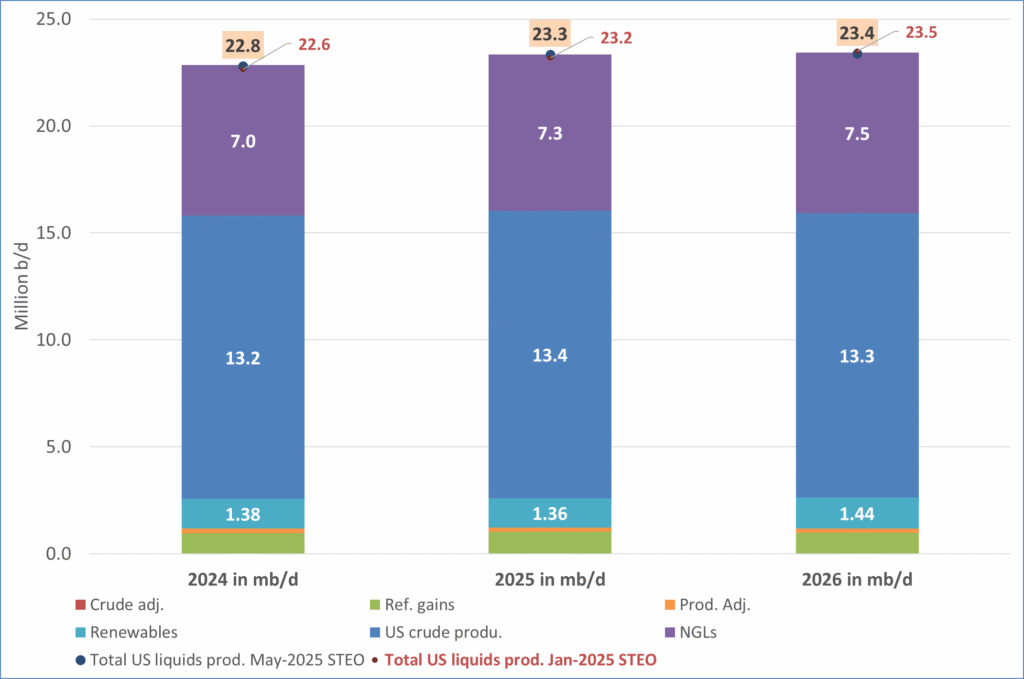
US IEA STEO September report. US crude oil production contracting in 2026, but NGLs still growing. Close to zero net liquids growth in total.
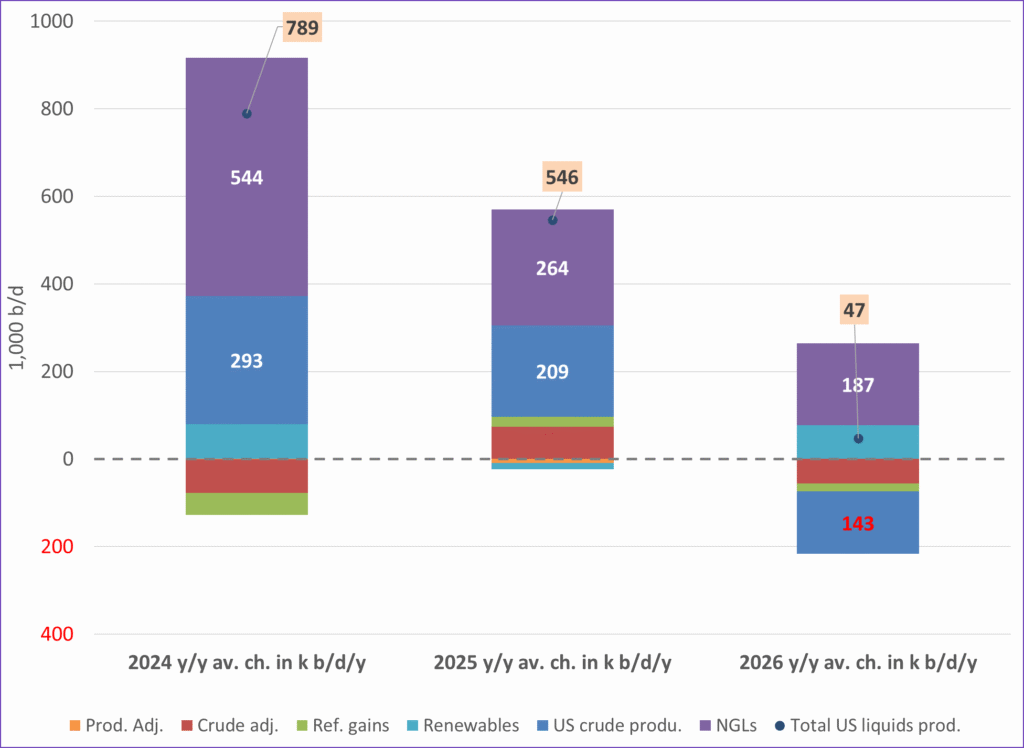
-

 Nyheter4 veckor sedan
Nyheter4 veckor sedanMeta bygger ett AI-datacenter på 5 GW och 2,25 GW gaskraftverk
-
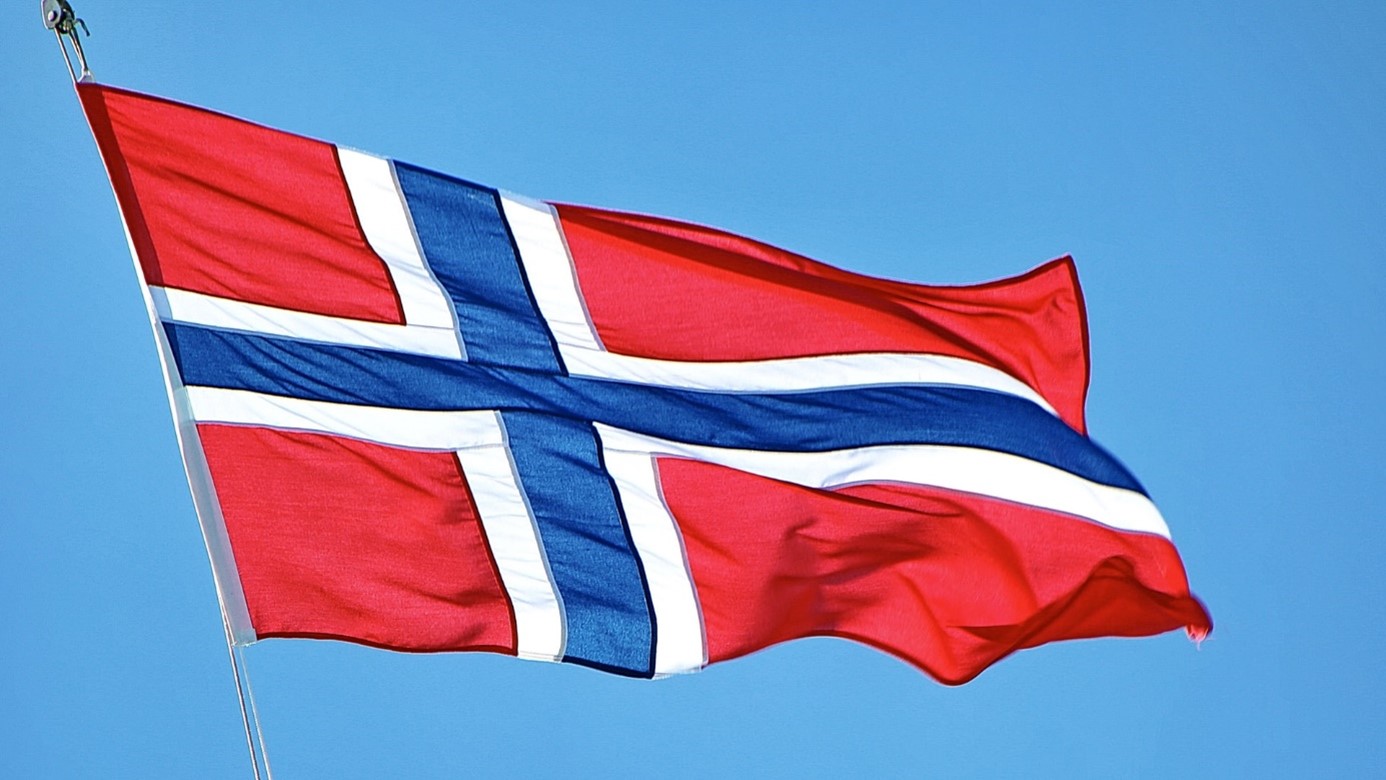
 Nyheter4 veckor sedan
Nyheter4 veckor sedanAker BP gör ett av Norges största oljefynd på ett decennium, stärker resurserna i Yggdrasilområdet
-

 Nyheter4 veckor sedan
Nyheter4 veckor sedanSommarens torka kan ge högre elpriser i höst
-

 Analys4 veckor sedan
Analys4 veckor sedanBrent edges higher as India–Russia oil trade draws U.S. ire and Powell takes the stage at Jackson Hole
-
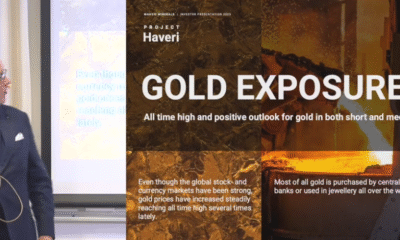
 Nyheter3 veckor sedan
Nyheter3 veckor sedanMahvie Minerals är verksamt i guldrikt område i Finland
-

 Analys4 veckor sedan
Analys4 veckor sedanIncreasing risk that OPEC+ will unwind the last 1.65 mb/d of cuts when they meet on 7 September
-

 Nyheter3 veckor sedan
Nyheter3 veckor sedanNeil Atkinson spår att priset på olja kommer att stiga till 70 USD
-

 Analys2 veckor sedan
Analys2 veckor sedanOPEC+ in a process of retaking market share


